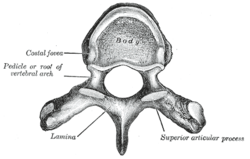Vasocorona
| Spinal canal | |
|---|---|

A typical thoracic vertebra viewed from above. (Spinal canal is not labeled, but the hole in the center would comprise part of a spinal canal.)
|
|
| Details | |
| Identifiers | |
| Latin | c. vertebralis |
| MeSH | A02.835.232.834.803 |
| Dorlands /Elsevier |
c_04/12208918 |
| TA | A02.2.00.009 |
| FMA | 9680 |
|
Anatomical terminology
[]
|
|
The spinal canal (or vertebral canal or spinal cavity) is the space in the vertebral column formed by the vertebrae through which the spinal cord passes. It is a process of the dorsal body cavity. This canal is enclosed within the vertebral foramen of the vertebrae. In the intervertebral spaces, the canal is protected by the ligamentum flavum posteriorly and the posterior longitudinal ligament anteriorly.
The outermost layer of the meninges, the dura mater, is closely associated with the arachnoid mater which in turn is loosely connected to the innermost layer, the pia mater. The meninges divide the spinal canal into the epidural space and the subarachnoid space. The pia mater is closely attached to the spinal cord. A subdural space is generally only present due to trauma and/or pathological situations. The subarachnoid space is filled with cerebrospinal fluid and contains the vessels that supply the spinal cord, namely the anterior spinal artery and the paired posterior spinal arteries, accompanied by corresponding spinal veins. The anterior and posterior spinal arteries form anastomoses known as the vasocorona of the spinal cord and these supply nutrients to the canal. The epidural space contains loose fatty tissue, and a network of large, thin-walled blood vessels called the internal vertebral venous plexuses.
...
Wikipedia
